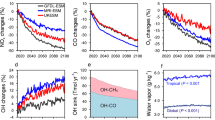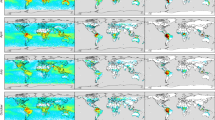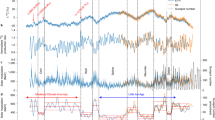Abstract
The hydroxyl radical is the predominant atmospheric oxidant1, responsible for removing a wide range of trace gases, including greenhouse gases, from the atmosphere. Determination of trends and variability in hydroxyl radical concentrations2,3 is critical to understanding whether the ‘cleansing’ properties of the atmosphere are changing. The variability in hydroxyl radical concentrations on annual to monthly timescales, however, is difficult to quantify. Here we show records of carbon monoxide containing radiocarbon (14CO), which is oxidized by hydroxyl radicals4,5, from clean-air sites at Baring Head, New Zealand, and Scott Base, Antarctica, spanning 13 years. Using a model study, we correct for known variations in production of 14CO (refs 6, 7), allowing us to exploit this species as a diagnostic for short term changes in hydroxyl radical concentrations. We find no significant long-term trend in hydroxyl radical concentrations but provide evidence for recurring short-term variations of around ten per cent persisting for a few months. We also find decreases in hydroxyl radical concentrations of up to 20 per cent, apparently triggered by the eruption of Mt Pinatubo in 1991 and by the occurrence of extensive fires in Indonesia in 1997.
This is a preview of subscription content, access via your institution
Access options
Subscribe to this journal
Receive 51 print issues and online access
$199.00 per year
only $3.90 per issue
Buy this article
- Purchase on Springer Link
- Instant access to full article PDF
Prices may be subject to local taxes which are calculated during checkout


Similar content being viewed by others
References
Levy, H. II Normal atmosphere: Large radical and formaldehyde concentrations predicted. Science 173, 141–143 (1971)
Prinn, R. G. et al. Evidence for substantial variations of atmospheric hydroxyl radicals in the past two decades. Science 292, 1882–1888 (2001)
Krol, M. & Lelieveld, J. Can the variability in tropospheric OH be deduced from measurements of 1,1,1-trichloroethane (methyl chloroform)? J. Geophys. Res. 108, 4125, doi:10.1029/2002JD002423 (2003)
Weinstock, B. & Niki, H. Carbon monoxide balance in nature. Science 176, 290–292 (1972)
Volz, A., Ehhalt, D. H. & Derwent, R. G. Seasonal and latitudinal variation of 14CO and the tropospheric concentration of OH radicals. J. Geophys. Res. 86, 5163–5171 (1981)
Masarik, J. & Beer, J. Simulation of particle fluxes and cosmogenic nuclide production in the Earth's atmosphere. J. Geophys. Res. 104, 12099–12111 (1999)
Lowe, D. C. & Allan, W. A simple procedure for evaluating global cosmogenic 14C production in the atmosphere using neutron monitor data. Radiocarbon 44, 149–157 (2002)
Brenninkmeijer, C. A. M. et al. Interhemispheric asymmetry in OH abundance inferred from measurements of atmospheric 14CO. Nature 356, 50–52 (1992)
Brenninkmeijer, C. A. M. Measurement of the abundance of 14CO in the atmosphere and the 13C/12C and 18O/16O ratio of atmospheric CO with applications in New Zealand and Antarctica. J. Geophys. Res. 98, 10595–10614 (1993)
Mak, J. E., Brenninkmeijer, C. A. M. & Tamaresis, J. Atmospheric 14CO observations and their use for estimating carbon monoxide removal rates. J. Geophys. Res. 99, 22915–22922 (1994)
Brenninkmeijer, C. A. M., Lowe, D. C., Manning, M. R., Sparks, R. J. & van Velthoven, P. F. J. The 13C, 14C and 18O isotopic composition of CO, CH4, and CO2 in the higher southern latitudes lower stratosphere. J. Geophys. Res. 100, 26163–26172 (1995)
Jöckel, P. & Brenninkmeijer, C. A. M. The seasonal cycle of cosmogenic 14CO at the surface level: A solar cycle adjusted, zonal-average climatology based on observations. J. Geophys. Res. 107, 4656, doi:10.1029/2001JD001104 (2002)
Quay, P. et al. Atmospheric 14CO: a tracer of OH concentration and mixing rates. J. Geophys. Res. 105, 15147–15166 (2000)
Spivakovsky, C. M. et al. Three-dimensional climatological distribution of tropospheric OH: Update and evaluation. J. Geophys. Res. 105, 8931–8980 (2000)
Jöckel, P., Brenninkmeijer, C. A. M., Lawrence, M. G., Jeuken, A. B. M. & Velthoven, P. F. J. v. Evaluation of stratosphere–troposphere exchange and the hydroxyl radical distribution in three-dimensional global atmospheric models using observations of cosmogenic 14CO. J. Geophys. Res. 107, 4446, doi:10.1029/2001JD001324 (2002)
Schauffler, S. & Daniel, J. On the effects of stratospheric circulation changes on trace gas trends. J. Geophys. Res. 99, 25747–25754 (1994)
Jöckel, P., Siegmund, P., Lawrence, M. G. & Brenninkmeijer, C. A. M. The detection of solar proton produced 14CO. Atmos. Chem. Phys. 3, 999–1005 (2003)
Thompson, D. W. J. & Solomon, S. Interpretation of recent southern hemisphere climate change. Science 296, 895–899 (2002)
Forster, P. M. d. F. & Tourpali, K. Effect of tropopause height changes on the calculation of ozone trends and their radiative forcing. J. Geophys. Res. 106, 12241–12251 (2001)
Santer, B. D. et al. Behaviour of tropopause height and atmospheric temperature in models, reanalyses, and observations. Part I: Decadal changes. J. Geophys. Res. 108, doi:10.1029/2002JD002258 (2003)
Kalnay, E. et al. The NCEP/NCAR 40-year reanalysis project. Bull. Am. Meteorol. Soc. 77, 437–471 (1996)
Allen, D. R., Bevilacqua, R. M., Nedoluha, G. E., Randall, C. E. & Manney, G. L. Unusual stratospheric transport and mixing during the 2002 Antarctic winter. Geophys. Res. Lett. 30, 1599, doi:1510.1029/2003GL017117 (2003)
Dlugokencky, E. J. et al. Changes in CH4 and CO growth rates after the eruption of Mt Pinatubo and their link with changes in tropical tropospheric UV flux. Geophys. Res. Lett. 23, 2761–2764 (1996)
Wooster, M. J. & Strub, N. Study of the 1997 Borneo fires: Quantitative analysis using global area coverage (GAC) satellite data. Glob. Biogeochem. Cycles 16, doi:10.1029/2000GB001357 (2002)
Matsueda, H. & Inoue, H. Y. Aircraft measurements of trace gases between Japan and Singapore in October of 1993, 1996, and 1997. Geophys. Res. Lett. 26, 2413–2416 (1999)
Novelli, P. C. et al. Reanalysis of tropospheric CO trends: Effects of the 1997–1998 wildfires. J. Geophys. Res. 108, doi:10.1029/2002JD003031 (2003)
Lowe, D. C. et al. Assessment of “storage correction” required for in situ 14CO production in air sample cylinders. Geophys. Res. Lett. 29, doi:10.1029/2002GL014719 (2002)
Bergamaschi, P., Hein, R., Heimann, M. & Crutzen, P. J. Inverse modeling of the global CO cycle: 1. Inversion of CO mixing ratios. J. Geophys. Res. 105, 1909–1928 (2000)
Jöckel, P., Lawrence, M. G. & Brenninkmeijer, C. A. M. Simulations of cosmogenic 14CO using the three-dimensional atmospheric model MATCH: Effects of 14C productions distribution and the solar cycle. J. Geophys. Res. 104, 11733–11743 (1999)
Bergamaschi, P. et al. Transects of atmospheric CO, CH4, and their isotopic composition across the Pacific: Shipboard measurements and validation of inverse models. J. Geophys. Res. 106, 7993–8011 (2000)
Acknowledgements
C. Brenninkmeijer helped to establish the 14CO measurement programme and R. Sparks, G. Brailsford and A. Gomez helped with the measurements and analysis used. This work was supported by the New Zealand Foundation for Research Science and Technology and Antarctica New Zealand. M.M. thanks S. Solomon for her support in completing this work.
Author information
Authors and Affiliations
Corresponding author
Ethics declarations
Competing interests
Reprints and permissions information is available at npg.nature.com/reprintsandpermissions. The authors declare no competing financial interests.
Supplementary information
Supplementary Notes
This file contains Supplementary Methods, Supplementary Table S1 and Supplementary Figure S1.
Rights and permissions
About this article
Cite this article
Manning, M., Lowe, D., Moss, R. et al. Short-term variations in the oxidizing power of the atmosphere. Nature 436, 1001–1004 (2005). https://doi.org/10.1038/nature03900
Received:
Accepted:
Issue Date:
DOI: https://doi.org/10.1038/nature03900
This article is cited by
-
On the Causes and Consequences of Recent Trends in Atmospheric Methane
Current Climate Change Reports (2019)
-
Nanoparticles in the environment: assessment using the causal diagram approach
Environmental Health (2012)
-
Strong correlation between levels of tropospheric hydroxyl radicals and solar ultraviolet radiation
Nature (2006)
-
Contribution of anthropogenic and natural sources to atmospheric methane variability
Nature (2006)
-
Natural bleach under scrutiny
Nature (2005)
Comments
By submitting a comment you agree to abide by our Terms and Community Guidelines. If you find something abusive or that does not comply with our terms or guidelines please flag it as inappropriate.



